Structural Characteristics and Assembly Mechanisms of Soil Microbial Communities under Water–Salt Gradients in Arid Regions
Abstract
1. Introduction
2. Materials and methods
2.1. Overview of the Study Area
2.2. Method
2.2.1. Sample Setting
2.2.2. Soil Sample Collection
2.2.3. Determination of Physical and Chemical Parameters
2.2.4. Soil Microbial Assay
2.2.5. Statistical Analysis
3. Results and Analysis
3.1. Water–Salt Gradients and Physicochemical Properties of Soils
3.2. Soil Microbial Community Composition under Different Water–Salt Gradients
3.3. Diversity Characteristics of Soil Microbial Communities under Different Water–Salt Gradients
3.4. Main Environmental Factors Affecting the Structure of Soil Microbial Communities
3.5. Co-Occurrence Network Characteristics of Microbial Communities under Different Water–Salt Gradients
3.6. Soil Microbial Community Assembly Process
4. Discussion
4.1. Variation of Soil Environmental Factors along the Water–Salt Gradients
4.2. Changes in Soil Microbial Community Structure along the Water–Salt Gradients
4.3. Relationship between Soil Microbial Community Structure and Environmental Factors
4.4. Characteristics of Soil Microbial Co-Occurrence Networks under Different Water–Salt Gradients
4.5. Mechanisms of Soil Microbial Community Assembly under Different Water–Salt Gradients
5. Conclusions
Supplementary Materials
Author Contributions
Funding
Data Availability Statement
Acknowledgments
Conflicts of Interest
References
- Scanlon, B.R.; Keese, K.E.; Flint, A.L.; Flint, L.E.; Gaye, C.B. Michael Edmunds, Ian Simmers. Global synthesis of groundwater recharge in semiarid and arid regions. Hydrol. Process. 2006, 20, 3335–3370. [Google Scholar] [CrossRef]
- Dai, A. Increasing drought under global warming in observations and models. Nat. Clim. Chang. 2013, 3, 52–58. [Google Scholar] [CrossRef]
- Reynolds, J.F.; Smith, D.M.S.; Lambin, E.F.; Turner, B.L.; Mortimore, M.; Batterbury, S.P.J.; Downing, T.E.; Dowlatabadi, H.; Fernández, R.J.; Herrick, J.E.; et al. Global Desertification: Building a Science for Dryland Development. Science 2007, 316, 847–851. [Google Scholar] [CrossRef] [PubMed]
- Bull, A.T.; Asenjo, J.A. Microbiology of hyper-arid environments: Recent insights from the Atacama Desert, Chile. Antonie Leeuwenhoek 2013, 103, 1173–1179. [Google Scholar] [CrossRef] [PubMed]
- Delgado-Baquerizo, M.; Gallardo, A.; Wallenstein, M.D.; Maestre, F.T. Vascular plants mediate the effects of aridity and soil properties on ammonia-oxidizing bacteria and archaea. FEMS Microbiol. Ecol. 2013, 85, 273–282. [Google Scholar] [CrossRef]
- Delgado-Baquerizo, M.; Maestre, F.T.; Gallardo, A.; Bowker, M.A.; Wallenstein, M.D.; Quero, J.L.; Ochoa, V.; Gozalo, B.; García-Gómez, M.; Soliveres, S.; et al. Decoupling of soil nutrient cycles as a function of aridity in global drylands. Nature 2013, 502, 672–676. [Google Scholar] [CrossRef]
- Maestre, F.T.; Delgado-Baquerizo, M.; Jeffries, T.C.; Eldridge, D.J.; Ochoa, V.; Gozalo, B.; Quero, J.L.; García-Gómez, M.; Gallardo, A.; Ulrich, W.; et al. Increasing aridity reduces soil microbial diversity and abundance in global drylands. Proc. Natl. Acad. Sci. USA 2015, 112, 15684–15689. [Google Scholar] [CrossRef]
- De Figueiredo, D.R.; Pereira, M.J.; Moura, A.; Silva, L.; Bárrios, S.; Fonseca, F.; Henriques, I.; Correia, A. Bacterial community composition over a dry winter in meso- and eutrophic Portuguese water bodies. FEMS Microbiol. Ecol. 2007, 59, 638–650. [Google Scholar] [CrossRef]
- Leng, F.; Cui, X.; Zhu, N.; Zhu, X.; Wang, X.; Wang, Y. Characterization of root microbial communities associated with Astragalus membranaceus and their correlation with soil environmental factors. Rhizosphere 2023, 25, 100656. [Google Scholar] [CrossRef]
- Li, S.-J.; Hua, Z.-S.; Huang, L.-N.; Li, J.; Shi, S.-H.; Chen, L.-X.; Kuang, J.-L.; Liu, J.; Hu, M. Microbial communities evolve faster in extreme environments. Sci. Rep. 2014, 4, 6205. [Google Scholar] [CrossRef]
- Bardgett, R.D.; Van Der Putten, W.H. Belowground biodiversity and ecosystem functioning. Nature 2014, 515, 505–511. [Google Scholar] [CrossRef] [PubMed]
- Griffiths, B.S.; Kuan, H.L.; Ritz, K.; Glover, L.A.; McCaig, A.E.; Fenwick, C. The relationship between microbial community structure and functional stability, tested experimentally in an upland pasture soil. Microb. Ecol. 2004, 47, 104–113. [Google Scholar] [CrossRef] [PubMed]
- Du, Q. Research on Soil Microbial Diversity Patterns and Influencing Factors in Arid Zones of China. Ph.D. Thesis, Lanzhou University, Lanzhou, China, 2021. [Google Scholar]
- Knelman, J.E.; Nemergut, D.R. Changes in community assembly may shift the relationship between biodiversity and ecosystem function. Front. Microbiol. 2014, 5, 424. [Google Scholar] [CrossRef] [PubMed]
- Mark, V. Conceptual synthesis in community ecology. Q. Rev. Biol. 2010, 85, 183–206. [Google Scholar]
- Stegen, J.C.; Lin, X.; Fredrickson, J.K.; Chen, X.; Kennedy, D.W.; Murray, C.J.; Rockhold, M.L. Quantifying community assembly processes and identifying features that impose them. ISME J. 2013, 7, 2069–2079. [Google Scholar] [CrossRef] [PubMed]
- Wang, Z.-B.; Sun, Y.-Y.; Li, Y.; Chen, X.-L.; Wang, P.; Ding, H.-T.; Chen, B.; Zhang, X.-Y.; Song, X.Y.; Wang, M.; et al. Significant Bacterial Distance-Decay Relationship in Continuous, Well-Connected Southern Ocean Surface Water. Microb. Ecol. 2020, 80, 73–81. [Google Scholar] [CrossRef]
- Wang, J.N. Analysis of Microbial Community Construction, Succession and Its Ecological Functions in the Yellow River Delta Wetlands. Ph.D. Thesis, Shandong University, Jinan, China, 2021. [Google Scholar]
- Xiong, J.; Zhu, J.; Dai, W.; Dong, C.; Qiu, Q.; Li, C. Integrating gut microbiota immaturity and disease-discriminatory taxa to diagnose the initiation and severity of shrimp disease. Environ. Microbiol. 2017, 19, 1490–1501. [Google Scholar] [CrossRef]
- Wang, J.; Shen, J.; Wu, Y.; Tu, C.; Soininen, J.; Stegen, J.C.; He, J.; Liu, X.; Zhang, L.; Zhang, E. Phylogenetic beta diversity in bacterial assemblages across ecosystems: Deterministic versus stochastic processes. ISME J. 2013, 7, 1310–1321. [Google Scholar] [CrossRef]
- Zhang, Y. Microbial Diversity of Inter-Root Soils of Typical Desert Salt Plants. Master’s Thesis, Xinjiang University, Urumqi, China, 2019. [Google Scholar]
- Yang, X.; Lv, G.; He, X.; Li, Y.; Zhang, X.; Wang, X.; Liu, W. Changes in soil enzyme activities among four typical communities in Abbey Lake Wetland Nature Reserve. Arid. Zone Res. 2017, 34, 1278–1285. [Google Scholar]
- Wang, Y.; Niu, Y.; Zhong, Z.; Hu, W.; Li, Y. Isolation and identification of mucilaginous bacteria from Lake Abbey wetlands and their antibacterial activity. Jiangsu Agric. Sci. 2022, 50, 234–242. [Google Scholar]
- Zhang, X.-N.; Lv, G.-H.; Wang, T.-Q.; Ma, Y.; Abdurehman, A.; Zhao, X.-Y.; Guo, Z.-J.; Zhu, X.-Y. Plant diversity patterns and their causes in vertical riparian zones of desert areas. J. Ecol. 2015, 35, 5966–5974. [Google Scholar]
- Zhang, X.D.; Li, Z.; Zhang, F. Soil nutrient, enzyme activity and microbial characteristics of different land use practices in the Aibi Lake area of Xinjiang. Soil Water Conserv. Res. 2017, 24, 91–96. [Google Scholar]
- Ma, X.; Chu, X.; Ma, Q. Effect of freeze-thaw on soil enzyme activity and microbial population in pike communities in Lake Abbey region. Geogr. Arid. Reg. 2015, 38, 1190–1201. [Google Scholar]
- Han, J. Dynamic Succession of Prokaryotic Microbial Communities and Changes in Dominant Community Composition in Response to the Environment in Lake Abbey Wetlands. Master’s Thesis, Shihezi University, Shihezi, China, 2014. [Google Scholar]
- Shao, L. Study on the Effect of Salinization of Lake Abbey on Soil Microbial Diversity. Master’s Thesis, Xinjiang University, Urumqi, China, 2012. [Google Scholar]
- Li, W.; Jiang, L.; Zhang, Y.; Teng, D.; Wang, H.; Wang, J.; Lv, G. Structure and driving factors of the soil microbial community associated with Alhagi sparsifolia in an arid desert. PLoS ONE 2021, 16, 0254065. [Google Scholar] [CrossRef] [PubMed]
- Evans, S.E.; Wallenstein, M.D. Soil microbial community response to drying and rewetting stress: Does historical precipitation regime matter? Biogeochemistry 2012, 109, 101–116. [Google Scholar] [CrossRef]
- Barnard Romain, L.; Osborne Catherine, A.; Firestone Mary, K. Responses of soil bacterial and fungal communities to extreme desiccation and rewetting. ISME J. 2013, 7, 2229–2241. [Google Scholar] [CrossRef]
- Crowe, J.H.; Crowe, L.M.; Chapman, D. Preservation of Membranes in Anhydrobiotic Organisms: The Role of Trehalose. Science 1984, 223, 701–703. [Google Scholar] [CrossRef]
- Zhang, K.; Shi, Y.; Cui, X.; Yue, P.; Li, K.; Liu, X.; Tripathi Binu, M.; Chu, H. Salinity Is a Key Determinant for Soil Microbial Communities in a Desert Ecosystem. mSystems 2019, 4, e00225-18. [Google Scholar] [CrossRef]
- Chen, L.; Hu, Q.; Zhang, X.; Chen, Z.; Wang, Y.; Liu, S. Effects of salinity on the biological performance of anaerobic membrane bioreactor. J. Environ. Manag. 2019, 238, 263–273. [Google Scholar] [CrossRef]
- Wang, S.; Wang, X.; Han, X.; Deng, Y. Higher precipitation strengthens the microbial interactions in semi-arid grassland soils. Glob. Ecol. Biogeogr. 2018, 27, 570–580. [Google Scholar] [CrossRef]
- Zhang, B.; Xue, K.; Zhou, S.; Wang, K.; Liu, W.; Xu, C.; Cui, L.; Li, L.; Ran, Q.; Wang, Z.; et al. Environmental selection overturns the decay relationship of soil prokaryotic community over geographic distance across grassland biotas. eLife 2022, 11, e70164. [Google Scholar] [CrossRef] [PubMed]
- Zhang, X. Study of Desert Plant Community Succession and Its Nutrient Drivers. Ph.D. Thesis, Xinjiang University, Urumqi, China, 2014. [Google Scholar]
- Layeghifard, M.; Hwang, D.M.; Guttman, D.S. Disentangling Interactions in the Microbiome: A Network Perspective. Trends Microbiol. 2017, 25, 217–228. [Google Scholar] [CrossRef] [PubMed]
- Yang, J.; Wang, C.; Bai, Y.; Hao, J.; Wang, H. Fast Update Algorithm for Social Network Meso-Centrality; NDBC: Hefei, China, 2012; pp. 254–260. [Google Scholar]
- Deng, M.J. Exploration of the top ten water ecological protection objectives and their countermeasures in Xinjiang. Arid. Zone Geogr. 2014, 37, 865–874. [Google Scholar]
- Zhang, X.-N.; Yang, X.-D.; Lu, G.-H. Desert plant diversity patterns under water-salt gradients and their relationship with soil environment. J. Ecol. 2016, 36, 3206–3215. [Google Scholar]
- García, C.; Hernández, T. Biological and biochemical indicators in derelict soils subject to erosion. Soil Biol. Biochem. 1997, 29, 171–177. [Google Scholar] [CrossRef]
- Brockett, B.F.T.; Prescott, C.E.; Grayston, S.J. Soil moisture is the major factor influencing microbial community structure and enzyme activities across seven biogeoclimatic zones in western Canada. Soil Biol. Biochem. 2012, 44, 9–20. [Google Scholar] [CrossRef]
- Zhang, J.; Sun, Q.; Makeschin, F. Effect of salt stress on the growth and soil enzyme activity of new asexual willow seedlings. J. Soil Water Conserv. 2005, 3, 125–129. [Google Scholar]
- Li, H.; Yao, T.; Zhang, J.; Gao, Y.; Ma, Y.; Lu, X.; Zhang, H.; Yang, X. Interrelationships between soil bacterial communities and soil environmental factors in degraded alpine grasslands of the Eastern Qilian Mountains. J. Appl. Ecol. 2018, 29, 3793–3801. [Google Scholar]
- Zhang, Q.; Zeng, X.; Han, Y.; Xiang, F.; Guo, C.; Chen, F.; Gu, Y. Effect of soil fumigant dazomet and biofertilizer on fungal diversity in strawberry continuous cropping soil. Microbiol. Lett. 2018, 45, 1048–1060. [Google Scholar]
- Zhao, J.; Xie, H.; Zhang, J. Microbial diversity and physicochemical properties of inter-root microenvironment in saline soils of the Yellow River Delta. Environ. Sci. 2020, 41, 1449–1455. [Google Scholar]
- Zhang, X.; Zhang, H.; Lu, C.; Pang, H.; Jin, C.; Gao, X.; Cheng, X.; Li, Y. Effects of different autumn watering years on soil bacterial communities in the Hetao irrigation area. Chin. Agric. Sci. 2019, 52, 3380–3392. [Google Scholar]
- Yan, N.; Marschner, P.; Cao, W.; Zuo, C.; Qin, W. Influence of salinity and water content on soil microorganisms. Int. Soil Water Conserv. Res. 2015, 3, 316–323. [Google Scholar] [CrossRef]
- Pan, Y.; Kang, P.; Hu, J.; Song, N. Bacterial community demonstrates stronger network connectivity than fungal community in desert-grassland salt marsh. Sci. Total Environ. 2021, 798, 149118. [Google Scholar] [CrossRef] [PubMed]
- Wang, C.; Xiao, R.; Guo, Y.; Wang, Q.; Cui, Y.; Xiu, Y.; Ma, Z.; Zhang, M. Changes in soil microbial community composition during Phragmites australis straw decomposition in salt marshes with freshwater pumping. Sci. Total Environ. 2021, 762, 143996. [Google Scholar] [CrossRef] [PubMed]
- Dumbrell, A.J.; Michaela, N.; Thorunn, H.; Calvin, D.; Fitter Alastair, H. Relative roles of niche and neutral processes in structuring a soil microbial community. ISME J. 2010, 4, 337–345. [Google Scholar] [CrossRef]
- Lauber, C.L.; Micah, H.; Rob, K.; Noah, F. Pyrosequencing-based assessment of soil pH as a predictor of soil bacterial community structure at the continental scale. Appl. Environ. Microbiol. 2009, 75, 5111–5120. [Google Scholar] [CrossRef]
- Fierer, N.; Jackson, R.B. The diversity and biogeography of soil bacterial communities. Proc. Natl. Acad. Sci. USA 2006, 103, 626–631. [Google Scholar] [CrossRef]
- Barin, M.; Aliasgharzad, N.; Olsson, P.A.; Rasouli-Sadaghiani, M. Salinity-induced differences in soil microbial communities around the hypersaline Lake Urmia. Soil Res. 2015, 53, 494–504. [Google Scholar] [CrossRef]
- Oren, A. Bioenergetic aspects of halophilism. Microbiol. Mol. Biol. Rev. MMBR 1999, 63, 334–348. [Google Scholar] [CrossRef]
- Lauber, C.L.; Strickland, M.S.; Bradford, M.A.; Fierer, N. The influence of soil properties on the structure of bacterial and fungal communities across land-use types. Soil Biol. Biochem. 2008, 40, 2407–2415. [Google Scholar] [CrossRef]
- Kennedy, N.M.; Gleeson, D.E.; Connolly, J.; Clipson, N.J.W. Seasonal and management influences on bacterial community structure in an upland grassland soil. FEMS Microbiol. Ecol. 2005, 53, 329–337. [Google Scholar] [CrossRef] [PubMed]
- Li, S.; Wu, F. Diversity and Co-occurrence Patterns of Soil Bacterial and Fungal Communities in Seven Intercropping Systems. Front. Microbiol. 2018, 9, 1521. [Google Scholar] [CrossRef] [PubMed]
- Jim, H. Soil Microbial Communities and Restoration Ecology: Facilitators or Followers? Science 2009, 325, 573–574. [Google Scholar]
- Xiong, W.; Li, R.; Ren, Y.; Liu, C.; Zhao, Q.; Wu, H.; Jousset, A.; Shen, Q. Distinct roles for soil fungal and bacterial communities associated with the suppression of vanilla Fusarium wilt disease. Soil Biol. Biochem. 2017, 107, 198–207. [Google Scholar] [CrossRef]
- Zheng, W.; Xue, D.; Li, X.; Deng, Y.; Rui, J.; Feng, K.; Wang, Z.-L. The responses and adaptations of microbial communities to salinity in farmland soils: A molecular ecological network analysis. Appl. Soil Ecol. 2017, 120, 239–246. [Google Scholar] [CrossRef]
- Xun, W.; Huang, T.; Li, W.; Ren, Y.; Xiong, W.; Ran, W.; Li, D.; Shen, Q.; Zhang, R. Alteration of soil bacterial interaction networks driven by different long-term fertilization management practices in the red soil of South China. Appl. Soil Ecol. 2017, 120, 128–134. [Google Scholar] [CrossRef]
- Ji, M.; Kong, W.; Yue, L.; Wang, J.; Deng, Y.; Zhu, L. Salinity reduces bacterial diversity, but increases network complexity in Tibetan Plateau lakes. FEMS Microbiol. Ecol. 2019, 95, fiz190. [Google Scholar] [CrossRef]
- Lv, B.; Shi, J.; Li, T.; Ren, L.; Tian, W.; Lu, X.; Han, Y.; Cui, Y.; Jiang, T. Deciphering the characterization, ecological function and assembly processes of bacterial communities in ship ballast water and sediments. Sci. Total Environ. 2021, 816, 152721. [Google Scholar] [CrossRef]
- Jiao, S.; Liu, Z.; Lin, Y.; Yang, J.; Chen, W.; Wei, G. Bacterial communities in oil contaminated soils: Biogeography and co-occurrence patterns. Soil Biol. Biochem. 2016, 98, 64–73. [Google Scholar] [CrossRef]
- Yang, H.; Fang, C.; Gao, J.; Jiao, F. Spatial distribution characteristics of mangrove sediment microorganisms and assessment of carbon sink capacity. J. Zhongshan Univ. 2023, 62, 1–9. [Google Scholar]
- Zhang, Y. A Study of the Cellular Behaviour of Marine Mucilaginous Bacteria and Their Molecular Mechanisms. Ph.D. Thesis, Shandong University, Jinan, China, 2005. [Google Scholar]
- Sun, J.; Liu, Y.; Zuo, Y.; Han, M.; Zhang, H.; Lv, J. Structure and function of inter-root soil bacterial communities in saline alkali ponies. Chin. J. Ecol. Agric. 2020, 28, 1618–1629. [Google Scholar]
- Wang, Z.M.; Mi, S.W.; Li, C.H.; Guo, J.; Tian, Y.; Gao, K.X.; He, B. Effect of biofertilizer of Trichoderma globosum on the growth of walnut seedlings. For. Sci. Technol. 2017, 42, 1–3. [Google Scholar]
- Li, L.; Yin, C.; Tian, Y.; Liu, X.; Gao, K.; He, B. Effect of Trichoderma globosum ND35 on physiological characteristics of bitter melon seedlings under drought stress. North. Hortic. 2018, 3, 16–21. [Google Scholar]
- Gonçalves, M.F.M. Three new species of Neocamarosporium isolated from saline environments: N. aestuarinum sp. nov., N. endophyticum sp. nov. and N. halimiones sp. nov. Mycosphere 2019, 10, 608–621. [Google Scholar] [CrossRef]
- Xin, M.X.; Zhao, Y.; Zhou, J.; Gao, W.C. Role of denitrifying bacteria in wastewater denitrification. Microbiol. Bull. 2007, 4, 773–776. [Google Scholar]
- Sui, W.; Li, J.; Wu, X.; Wu, Q.; Ma, Y.; Zhang, X.; Zhang, X. Bacterial mechanisms of sulfide inhibition of nitrous oxide reduction during denitrification in tidal soils. Microbiol. Lett. 2020, 47, 3114–3125. [Google Scholar]
- Mouad, L.; Hanane, L.; Omar, B.; Meryeme, B.; Hanaa, A.; Bedmar, E.J.; El Idrissi Mustapha, M. Nodulation of Retama species by members of the genus Microvirga in Morocco. Symbiosis 2020, 82, 249–258. [Google Scholar] [CrossRef]
- Trishul, A.; Mukesh, D. Biodegradation of physicochemically treated polycarbonate by fungi. Biomacromolecules 2010, 11, 20–28. [Google Scholar]
- Feng, C.H.; Sun, G.Y. New taxonomic advances in the genus Streptomyces and related genera. Mycologia 2020, 18, 294–303. [Google Scholar]
- Yin, H.; Huang, K.; Wang, Q.; Li, S. Analysis of microbial community changes in AAO biochemical system of a wastewater treatment plant under high salinity environment. Environ. Eng. 2021, 39, 68–74. [Google Scholar]
- Dong, L.S. Conexibacter stalactiti sp. nov., isolated from stalactites in a lava cave and emended description of the genus Conexibacter. Int. J. Syst. Evol. Microbiol. 2017, 67, 3214–3218. [Google Scholar]
- Chase, J.M. Stochastic community assembly causes higher biodiversity in more productive environments. Science 2010, 328, 1388–1391. [Google Scholar] [CrossRef] [PubMed]
- Graham, E.B.; Stegen, J.C. Dispersal-Based Microbial Community Assembly Decreases Biogeochemical Function. Processes 2017, 5, 65. [Google Scholar] [CrossRef]
- Li, L.; Ivan, N.; Hans, D.B.; Olga, V.; Simon, R.; Chase, D.; Lin, Z.; Erik, V. Longer dry and wet spells alter the stochasticity of microbial community assembly in grassland soils. Soil Biol. Biochem. 2023, 178, 108969. [Google Scholar] [CrossRef]
- Shi, Y.; Li, Y.; Xiang, X.; Sun, R.; Yang, T.; He, D.; Zhang, K.; Ni, Y.; Zhu, Y.G.; Adams, J.M.; et al. Spatial scale affects the relative role of stochasticity versus determinism in soil bacterial communities in wheat fields across the North China Plain. Microbiome 2018, 6, 1–12. [Google Scholar] [CrossRef]
- Leibold, M.A.; Holyoak, M.; Mouquet, N.; Amarasekare, P.; Chase, J.M.; Hoopes, M.F.; Holt, R.D.; Shurin, J.B.; Law, R.; Tilman, D.; et al. The metacommunity concept: A framework for multi-scale community ecology. Ecol. Lett. 2004, 7, 601–613. [Google Scholar] [CrossRef]
- Peay, K.G.; Kennedy, P.G.; Talbot, J.M. Dimensions of biodiversity in the Earth mycobiome. Nat. Rev. Microbiol. 2016, 14, 434–447. [Google Scholar] [CrossRef]
- Legendre, P.; Mi, X.; Ren, H.; Ma, K.; Yu, M.; Sun, I.-F.; He, F. Partitioning beta diversity in a subtropical broad-leaved forest of China. Ecology 2009, 90, 663–674. [Google Scholar] [CrossRef]

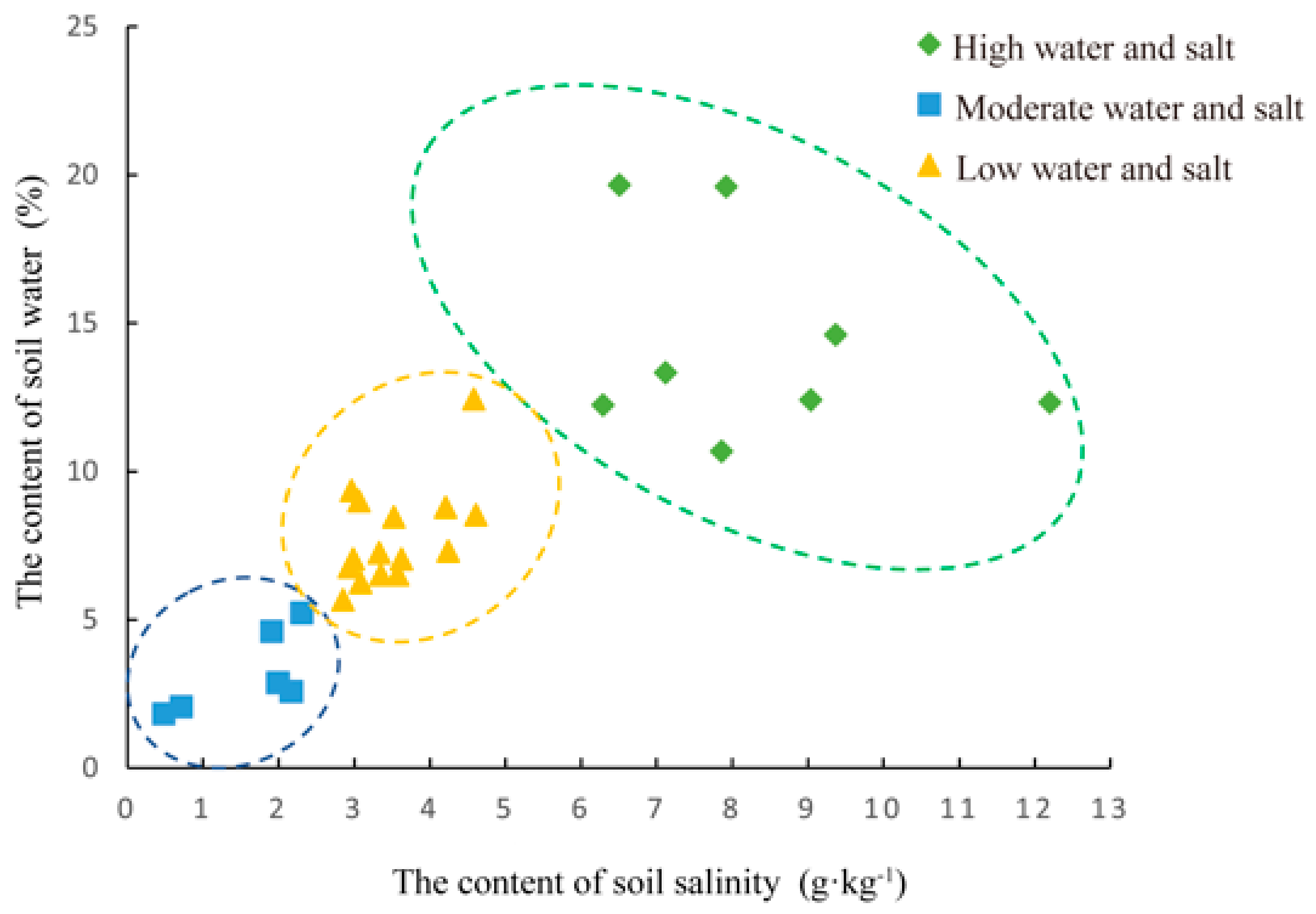
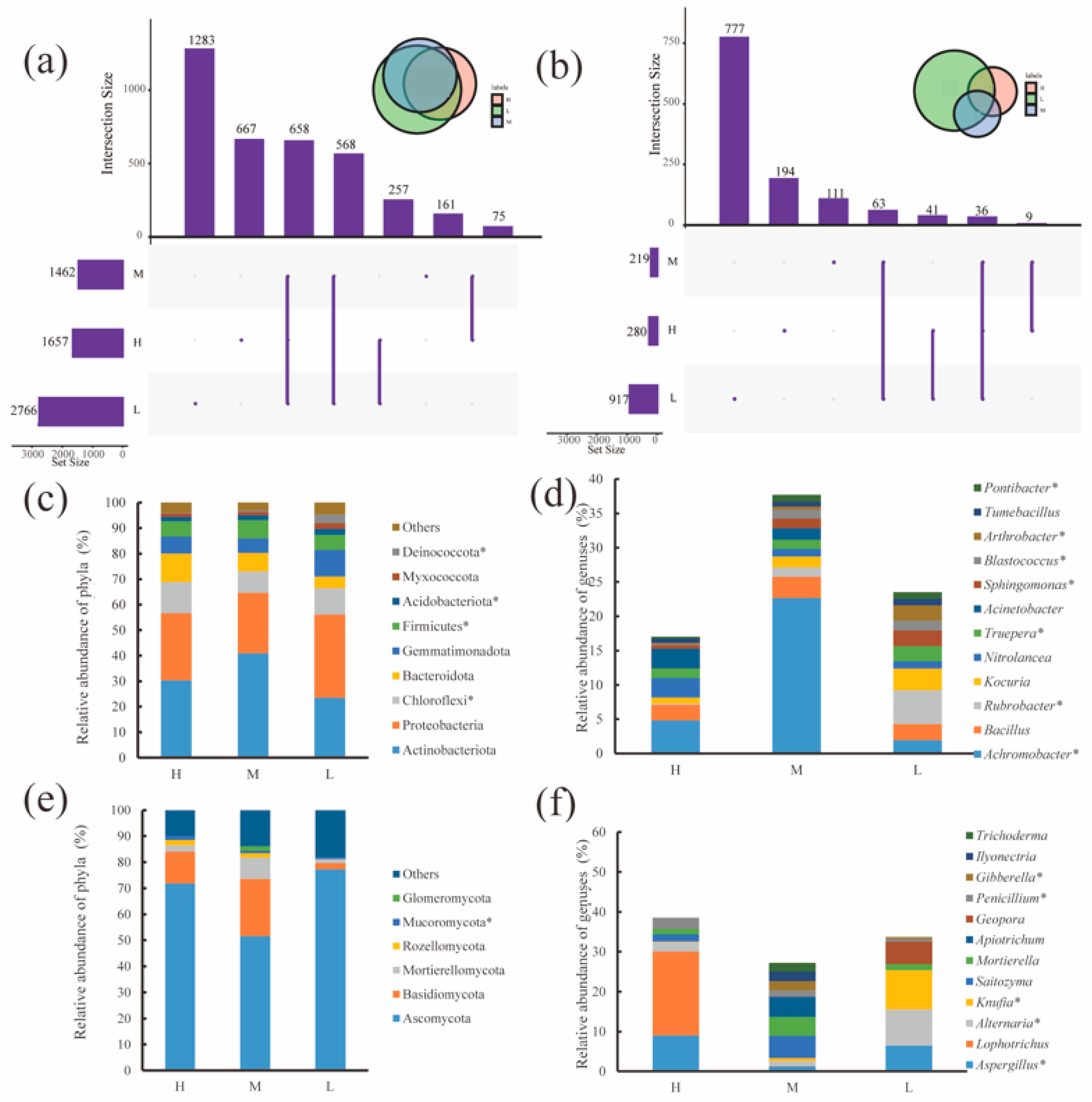
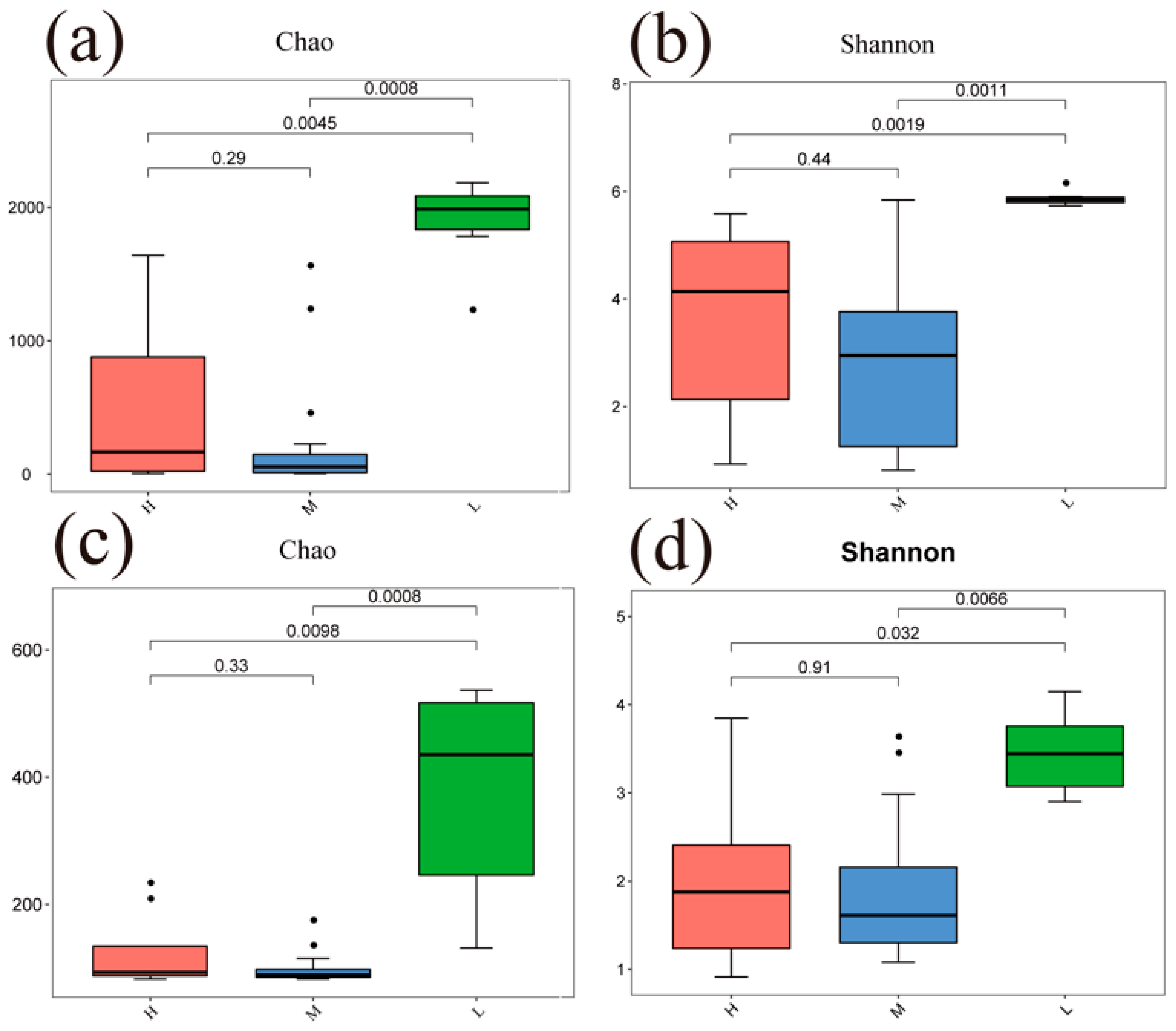
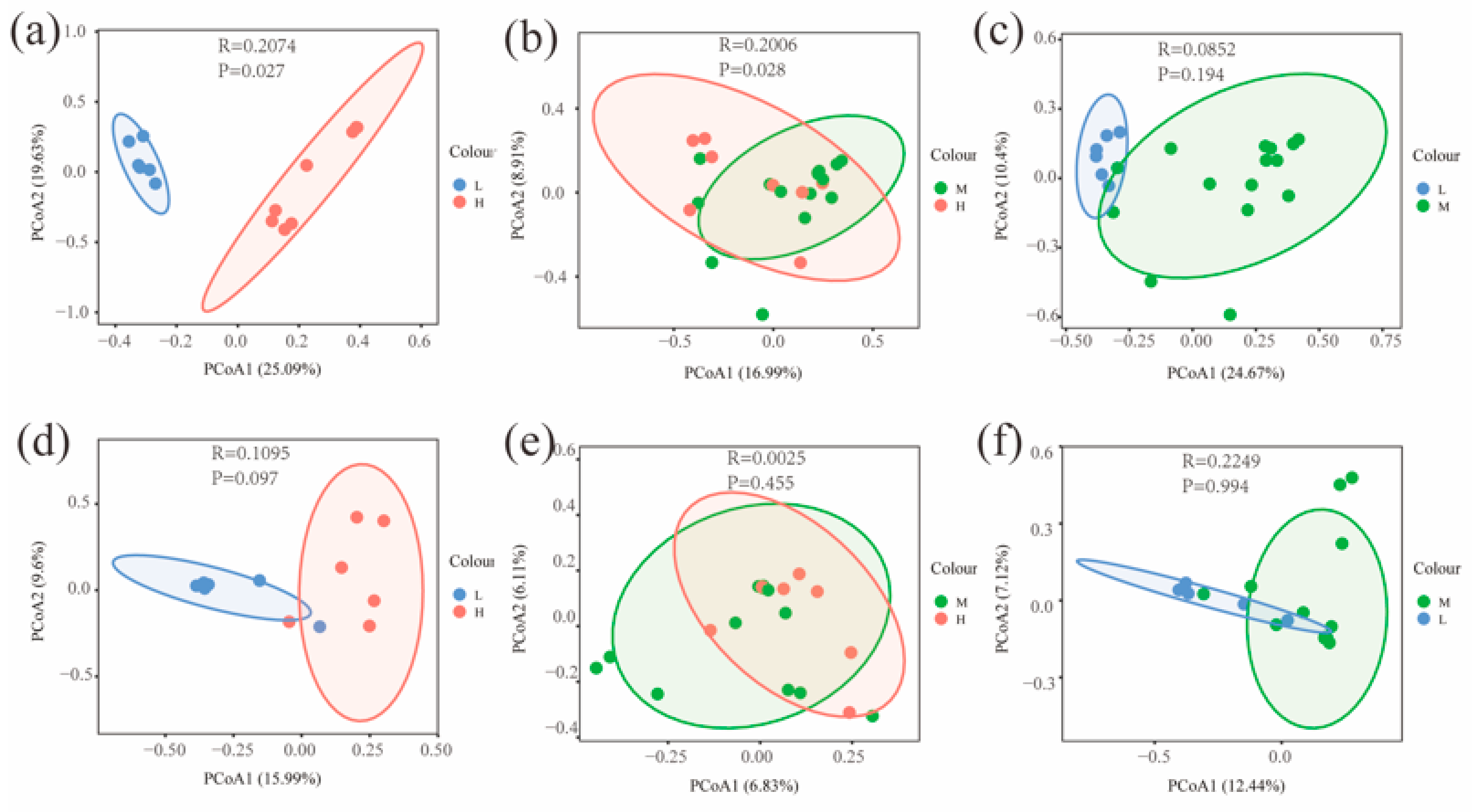
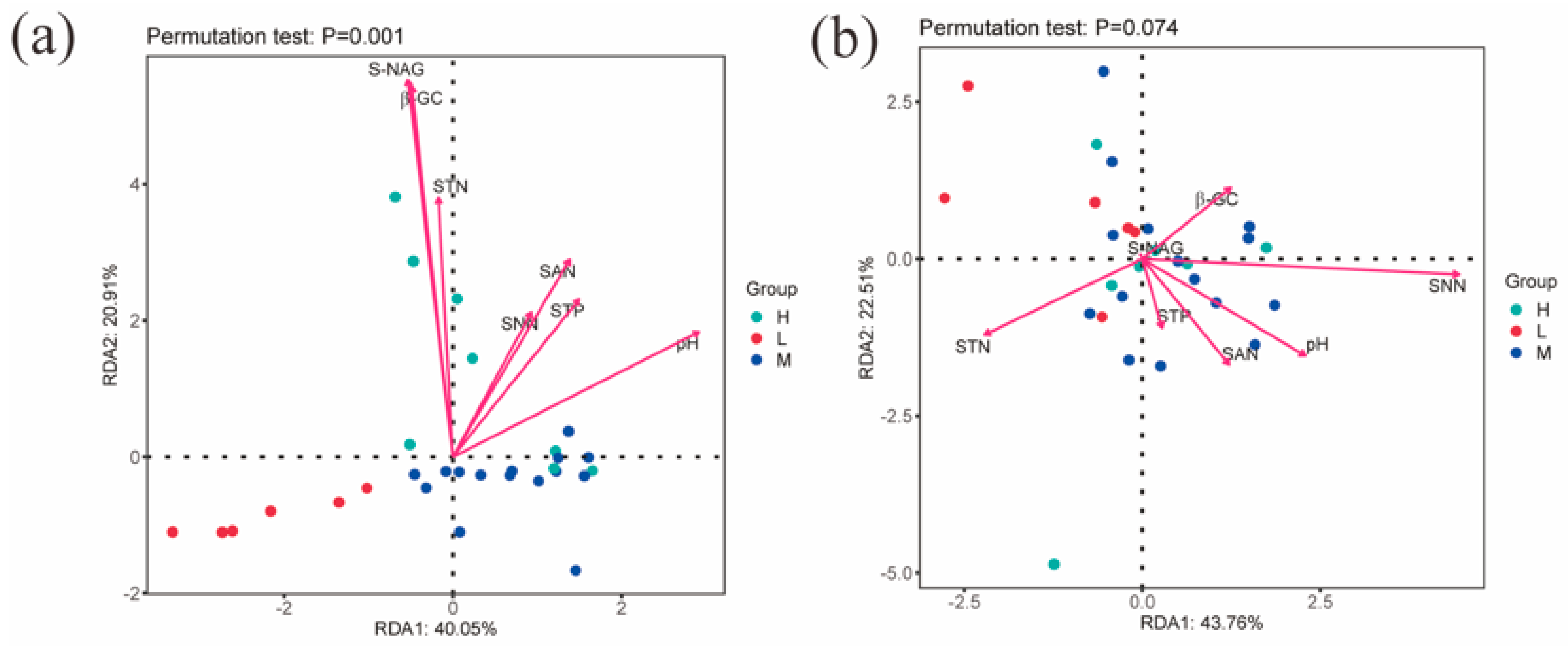



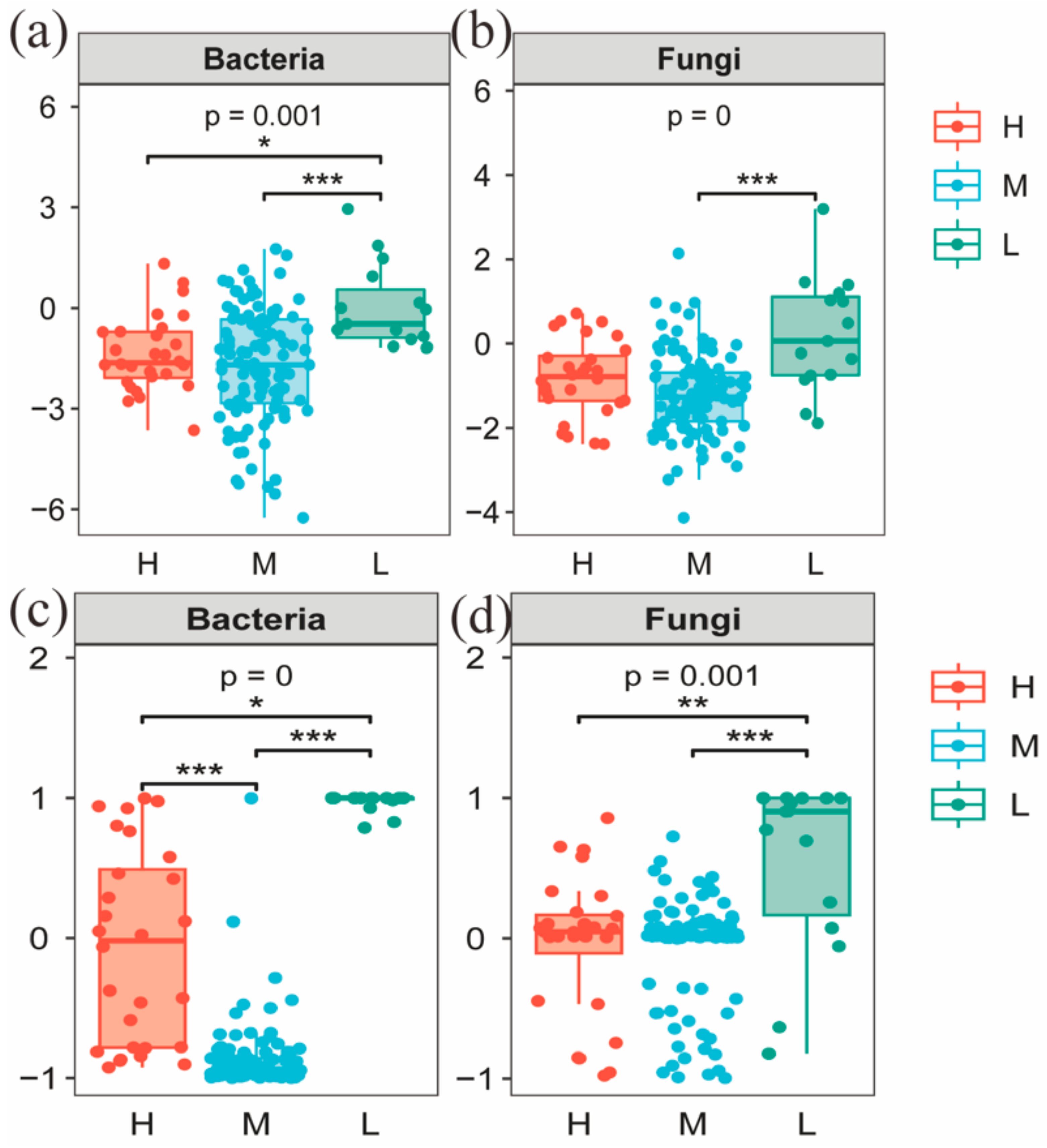

| OTUs | Chao | Shannon | Bray_Curtis | βMNTD | |
|---|---|---|---|---|---|
| STP | 0.034 | −0.271 | −0.224 | 0.057 | 0.062 |
| SAP | 0.323 | −0.101 | −0.045 | −0.086 | −0.151 |
| STN | 0.275 | −0.025 | 0.091 | −0.069 | −0.060 |
| SNN | 0.093 | −0.296 | −0.098 | 0.087 | 0.005 |
| SAN | 0.091 | −0.331 | −0.158 | −0.023 | −0.090 |
| SOC | 0.375 * | 0.083 | 0.126 | −0.078 | −0.126 |
| pH | −0.158 | −0.494 ** | −0.383 * | 0.146 * | −0.082 |
| LAP | 0.468 * | 0.108 | 0.176 * | −0.137 | −0.137 |
| Β-GC | 0.432 * | 0.090 | 0.202 | −0.086 | −0.104 |
| NAG | 0.394 * | 0.086 | 0.154 | −0.101 | −0.101 |
| AKP | 0.418 * | 0.180 | 0.215 | −0.109 | −0.123 |
| OTUs | Chao | Shannon | Bray_Curtis | βMNTD | |
|---|---|---|---|---|---|
| STP | −0.079 | −0.332 | −0.267 | −0.006 | 0.111 |
| SAP | −0.064 | −0.224 | −0.136 | −0.013 | 0.611 * |
| STN | −0.094 | −0.060 | −0.138 | −0.091 | 0.026 |
| SNN | −0.383 * | −0.371 | −0.317 | 0.083 | −0.009 |
| SAN | −0.164 | −0.440 | −0.390 * | 0.129 | 0.317 ** |
| SOC | 0.138 | 0.005 | 0.005 | −0.099 | 0.757 * |
| pH | −0.575 ** | −0.504 ** | −0.489 ** | 0.074 | 0.045 |
| LAP | 0.131 | −0.048 | 0.018 | −0.130 | 0.649 * |
| β-GC | 0.256 | −0.802 | 0.041 | −0.047 | 0.611 * |
| NAG | 0.238 | −0.034 | 0.042 | −0.084 | 0.789 * |
| AKP | 0.255 | 0.050 | 0.104 | −0.062 | 0.815 * |
| Bacteria | Fungi | |||||
|---|---|---|---|---|---|---|
| Water-salt gradients | H | M | L | H | M | L |
| Nodes | 287 | 291 | 292 | 56 | 61 | 108 |
| Edges | 14,472 | 21,766 | 6524 | 404 | 387 | 1043 |
| Positive edges/% | 100 | 100 | 60.8 | 100 | 100 | 84.0 |
| Negative edges/% | 0 | 0 | 39.2 | 0 | 0 | 16.0 |
| Degree | 100.85 | 149.60 | 44.69 | 14.429 | 12.690 | 19.310 |
| Clustering coefficient | 0.809 | 0.787 | 0.520 | 0.632 | 0.880 | 0.916 |
| Modularity | 0.283 | 0.181 | 1.911 | 0.524 | 0.532 | 0.454 |
| Sample Plot | Deterministic Processes (Bacteria/Fungi) | Stochastic Process (Bacteria/Fungi) | Homogeneous Processes (Bacteria/Fungi) | Heterogeneous Processes (Bacteria/Fungi) |
|---|---|---|---|---|
| H | 28.57%/14.29% | 71.43%/85.71% | 0.00%/21.43% | 35.71%/0.00% |
| M | 40.95%/21.90% | 59.05%/78.10% | 35.24%/24.76% | 41.90%/0.95% |
| L | 6.67%/6.67% | 93.33%/93.33% | 6.67%/0.00% | 73.33/40.00% |
Disclaimer/Publisher’s Note: The statements, opinions and data contained in all publications are solely those of the individual author(s) and contributor(s) and not of MDPI and/or the editor(s). MDPI and/or the editor(s) disclaim responsibility for any injury to people or property resulting from any ideas, methods, instructions or products referred to in the content. |
© 2023 by the authors. Licensee MDPI, Basel, Switzerland. This article is an open access article distributed under the terms and conditions of the Creative Commons Attribution (CC BY) license (https://creativecommons.org/licenses/by/4.0/).
Share and Cite
Yang, G.; Jiang, L.; Li, W.; Li, E.; Lv, G. Structural Characteristics and Assembly Mechanisms of Soil Microbial Communities under Water–Salt Gradients in Arid Regions. Microorganisms 2023, 11, 1060. https://doi.org/10.3390/microorganisms11041060
Yang G, Jiang L, Li W, Li E, Lv G. Structural Characteristics and Assembly Mechanisms of Soil Microbial Communities under Water–Salt Gradients in Arid Regions. Microorganisms. 2023; 11(4):1060. https://doi.org/10.3390/microorganisms11041060
Chicago/Turabian StyleYang, Guang, Lamei Jiang, Wenjing Li, Eryang Li, and Guanghui Lv. 2023. "Structural Characteristics and Assembly Mechanisms of Soil Microbial Communities under Water–Salt Gradients in Arid Regions" Microorganisms 11, no. 4: 1060. https://doi.org/10.3390/microorganisms11041060
APA StyleYang, G., Jiang, L., Li, W., Li, E., & Lv, G. (2023). Structural Characteristics and Assembly Mechanisms of Soil Microbial Communities under Water–Salt Gradients in Arid Regions. Microorganisms, 11(4), 1060. https://doi.org/10.3390/microorganisms11041060






